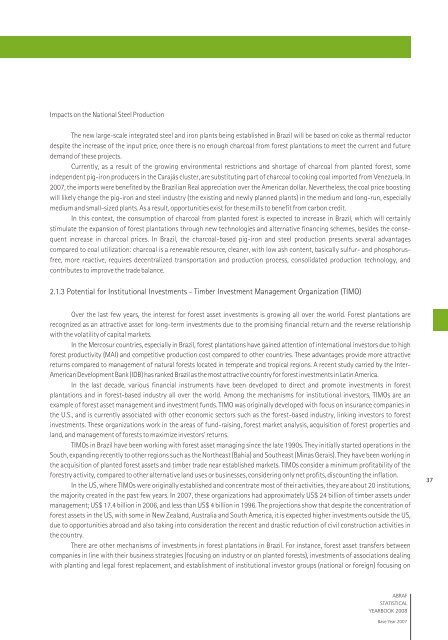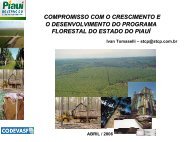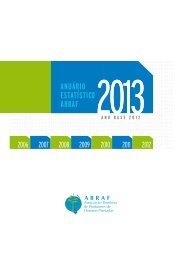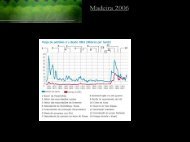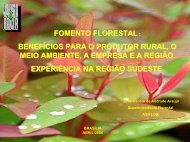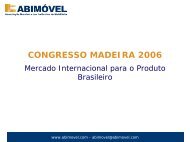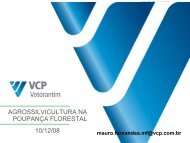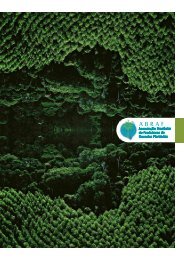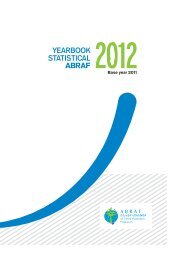ABRAF STATISTICAL YEARBOOK - Associação Brasileira de ...
ABRAF STATISTICAL YEARBOOK - Associação Brasileira de ...
ABRAF STATISTICAL YEARBOOK - Associação Brasileira de ...
You also want an ePaper? Increase the reach of your titles
YUMPU automatically turns print PDFs into web optimized ePapers that Google loves.
Impacts on the National Steel ProductionThe new large-scale integrated steel and iron plants being established in Brazil will be based on coke as thermal reductor<strong>de</strong>spite the increase of the input price, once there is no enough charcoal from forest plantations to meet the current and future<strong>de</strong>mand of these projects.Currently, as a result of the growing environmental restrictions and shortage of charcoal from planted forest, somein<strong>de</strong>pen<strong>de</strong>nt pig-iron producers in the Carajás cluster, are substituting part of charcoal to coking coal imported from Venezuela. In2007, the imports were benefited by the Brazilian Real appreciation over the American dollar. Nevertheless, the coal price boostingwill likely change the pig-iron and steel industry (the existing and newly planned plants) in the medium and long-run, especiallymedium and small-sized plants. As a result, opportunities exist for these mills to benefit from carbon credit.In this context, the consumption of charcoal from planted forest is expected to increase in Brazil, which will certainlystimulate the expansion of forest plantations through new technologies and alternative financing schemes, besi<strong>de</strong>s the consequentincrease in charcoal prices. In Brazil, the charcoal-based pig-iron and steel production presents several advantagescompared to coal utilization: charcoal is a renewable resource, cleaner, with low ash content, basically sulfur- and phosphorusfree,more reactive, requires <strong>de</strong>centralized transportation and production process, consolidated production technology, andcontributes to improve the tra<strong>de</strong> balance.2.1.3 Potential for Institutional Investments - Timber Investment Management Organization (TIMO)Over the last few years, the interest for forest asset investments is growing all over the world. Forest plantations arerecognized as an attractive asset for long-term investments due to the promising financial return and the reverse relationshipwith the volatility of capital markets.In the Mercosur countries, especially in Brazil, forest plantations have gained attention of international investors due to highforest productivity (MAI) and competitive production cost compared to other countries. These advantages provi<strong>de</strong> more attractivereturns compared to management of natural forests located in temperate and tropical regions. A recent study carried by the Inter-American Development Bank (IDB) has ranked Brazil as the most attractive country for forest investments in Latin America.In the last <strong>de</strong>ca<strong>de</strong>, various financial instruments have been <strong>de</strong>veloped to direct and promote investments in forestplantations and in forest-based industry all over the world. Among the mechanisms for institutional investors, TIMOs are anexample of forest asset management and investment funds. TIMO was originally <strong>de</strong>veloped with focus on insurance companies inthe U.S., and is currently associated with other economic sectors such as the forest-based industry, linking investors to forestinvestments. These organizations work in the areas of fund-raising, forest market analysis, acquisition of forest properties andland, and management of forests to maximize investors' returns.TIMOs in Brazil have been working with forest asset managing since the late 1990s. They initially started operations in theSouth, expanding recently to other regions such as the Northeast (Bahia) and Southeast (Minas Gerais). They have been working inthe acquisition of planted forest assets and timber tra<strong>de</strong> near established markets. TIMOs consi<strong>de</strong>r a minimum profitability of theforestry activity, compared to other alternative land uses or businesses, consi<strong>de</strong>ring only net profits, discounting the inflation.In the US, where TIMOs were originally established and concentrate most of their activities, they are about 20 institutions,the majority created in the past few years. In 2007, these organizations had approximately US$ 24 billion of timber assets un<strong>de</strong>rmanagement; US$ 17.4 billion in 2006, and less than US$ 4 billion in 1996. The projections show that <strong>de</strong>spite the concentration offorest assets in the US, with some in New Zealand, Australia and South America, it is expected higher investments outsi<strong>de</strong> the US,due to opportunities abroad and also taking into consi<strong>de</strong>ration the recent and drastic reduction of civil construction activities inthe country.There are other mechanisms of investments in forest plantations in Brazil. For instance, forest asset transfers betweencompanies in line with their business strategies (focusing on industry or on planted forests), investments of associations <strong>de</strong>alingwith planting and legal forest replacement, and establishment of institutional investor groups (national or foreign) focusing on37<strong>ABRAF</strong><strong>STATISTICAL</strong><strong>YEARBOOK</strong> 2008Base Year 2007


